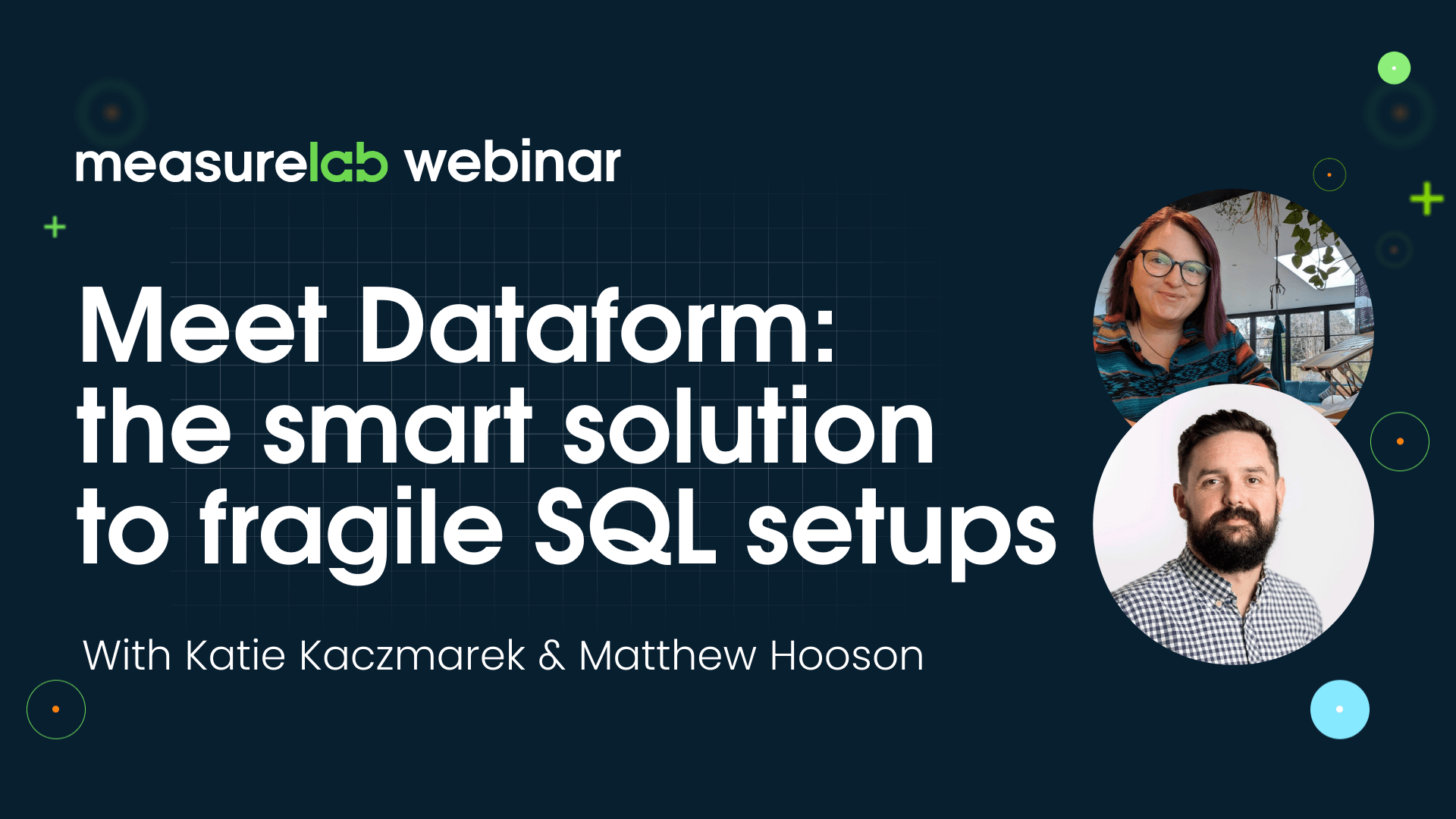Measured Opinions #8: The 15 minute GA audit

This week Dan and Dara (literally) run through an audit for Universal Analytics properties in 15 minutes. They touch on many of the key areas that are commonly an issue when looking at GA and how to identify and fix them.
Useful Custom Dimensions from Simo Ahava – https://bit.ly/3hztMKP.
View setup best practices from Steven Johnson – https://bit.ly/3A0MqCu.
Important view filters to use from Benjamin Mangold – https://bit.ly/3zWBp4R.
In other news, Dan plays more games and Dara goes campervanning!
Leave a rating and review in the places one leaves ratings and reviews, or suggest a new topic by emailing Dan and Dara at hello@measurelab.co.uk.
Transcript
[00:00:17] Dara: Hello and thanks for joining us in The Measure Pod, a podcast for analytics enthusiasts where we try and make sense of some topics in the analytics industry and have a little bit of fun along the way. I’m Dara MD here at Measurelab, I’m joined as always by Measurelab’s longest serving Analytics Consultant, Dan.
[00:00:36] Dan: Hey Dara.
[00:00:37] Dara: Hey Dan, how’re you doing?
[00:00:38] Dan: Yeah, good thank you. How are you?
[00:00:40] Dara: Good. So going to do things slightly differently this week, because we’ve got a topic that could take a bit of time, so we’re going to go straight into it. And what we’re going to cover this week is, we’re going to aim to do it in 15 minutes, it’s going to be a 15 minutes GA audit. And Dan and I are going to talk through some of the things that we think are the most important to check when you’re auditing a Google Analytics, Universal Analytics account set up. So you’re ready, Dan?
[00:01:07] Dan: I’m ready. Let’s go for it.
[00:01:08] Dara: Let’s do it. Okay, so I think we should start within the admin view. So I think this is usually where we would start doing an audit. We do a run through of the configuration of the account, the property to views. So let’s talk through some of the top tips for what we should check in the admin settings.
[00:01:26] Dan: Yeah, of course. And this is just to get some bearings, right? I mean, we’re not going to find any valuable insight in terms of any data stuff up here, but it’s just to get a sense of what we’re looking at when we start looking at the data. So the first thing I would look at is the view structure and making sure first of all, that there is multiple views per property. So the advice given for Google Analytics is that you always have at least two views for each property. You have a filtered and an unfiltered view. And you can have as many more additional views as you’d like, but making sure you’ve got your untouched view just in case you need a backup. But then also have your source of truth data set – your filtered, manipulated and cleaned view.
[00:02:01] Dara: One tip I’d just add to that about the unfiltered views. So, a common mistake I see is when the unfiltered views don’t have all of the settings enabled, so it might not have an Ads account linked to that view, for example. It should be a copy of the reporting view with the single exception that nothing is being filtered out of that view.
[00:02:21] Dan: Yeah, good point. The next thing I’d look at on the filtered view is the filters themselves. There’s a couple of standard filters that would always look for such as a lower casing some common dimensions like the UTM mediums and sources, and maybe even the page URLs. But also to exclude or include data that they don’t need in there. There’s also a box exclusion check box on the view settings that I always check to make sure it’s enabled for the main filtered view.
[00:02:45] Dara: Speaking of exclusions, we’d also check that any referral exclusions have been added, that’s at a property level. Also looking to see if any additional organic search engines needed to be added to the list.
[00:02:58] Dan: Yeah, and these are the things that we can come back to once we have looked at some of the data, because we don’t want to check to see if things like PayPal are added as a referral exclusion before we know that they’re even using PayPal. But some due diligence, just to make sure that they’re being used as a feature. And if so, that they’re going to be set up correctly. And I suppose we’ll validate the correctness of it when we start looking at the data. The next one is going to be the channel groupings. So there’s a Default Channel Grouping for all views, but I want to see if that’s been edited in any way. It’s pretty limited in its basic form. So making some adjustments there, for example around social media, paid and organic social, those kinds of things. Also to see if there’s any Custom Channel Groupings enabled. Just again, to show that they’re using these features and When we start looking at the data, we’ve got different ways of slicing and dicing.
[00:03:39] Dara: When you’re in the admin view, it’s also a good idea to take a look at the hit volume that’s being collected, and this is done at the property level. So you might want to do this to see if you’re getting near the 10 million hits per month, which is the allowance for standard GA.
[00:03:54] Dan: The last two that probably worth talking around are the goals and the custom definitions. So I will go check in their goals to see if they’re using any of the 20 that they have available as well as the 20 custom dimensions and 20 custom metrics. And with the custom dimensions, there’s always a few that we would like to expect things like User IDs, Client IDs, Timestamps. These are some common ones that have been adopted within the industry. So I always check to see if not only are they using the feature, but do they have these best practices implemented.
[00:04:22] Dara: Final point is to actually regularly look at the access management. So it’s pretty common for users to remain with access to GA accounts even after they’ve left the business or it could be an agency that still has access after you’ve stopped working with them.
[00:04:37] Dan: Yeah, really good point. I’ve had to up my cap a couple of times with Google because I get added on these things and then never get taken off.
[00:04:43] Dara: Exactly, access to far more than I need. Okay. So usually that’s the bit we get out of the way first and foremost, and then we start diving into the actual reports. So we’re not going to have time to cover everything that we would check in every report. But let’s talk through some of the main reports that we would look in as part of a GA audit and what are some of the common mistakes that we find. If we think of the GA interface and the report sets in the left-hand side, if we jumped straight into Audience, something that people don’t often look at within GA, but can be really, really insightful is looking at the different browsers and browser versions of the users that are viewing your website. Where this can be really helpful is if you have browser compatibility issues and on numerous occasions before I’ve looked at this report and I’ve looked at conversion rate and ranked it by weighted sort, and you can find browser versions and they send a lot of traffic to the site, but they’re actually not converting or they have a very, very low conversion rate. And it can be a sign that there’s an issue in the checkout for that particular browser or browser version.
[00:05:51] Dan: And also it’s good to check the new user rates and bounce rates at this point as well. We’re really looking for the extremes, like the zeros or a hundred percents here. Same with the conversion rates, if you have a hundred percent or a 0% conversion rate, there’s a red flag that should go off.
[00:06:04] Dara: Yeah, that’s a good point. As much as it is about checking that the user’s viewing your site aren’t experiencing any compatibility issues. Seeing a strange data associated with different browsers or browser versions can be a sign of spam or bot traffic that hasn’t been filtered out as well.
[00:06:21] Dan: On the same vein, you can also look at the browser size and screen resolution as well. These are two things that can be added and even side-by-side within the same set of reports. So the size is really important too, to see if there is any ways to cut the data that may look normal into something that might identify some of these issues that you’ve already stated Dara. So if there’s any landscape or portrait resolutions that are showing some issues within the bounce rates or conversion rates that we might not have seen at an aggregate level.
[00:06:47] Dara: Another report that’s not looked at very often that sits within the Audience section of reports is the Hostname reports. So it’s not a report you need to look out very often, but what it will show you is what domains are collecting data into your Google Analytics accounts. So you should really only expect to see your own website and any subdomains of that. Maybe if you’re tracking across domains, you would expect to see other domains as well, but they should all be recognized to you. If you see any other sites within the host name reports, it could be a sign that you’re GA tracking code is sitting on other websites, for one reason or another.
[00:07:27] Dan: And this is where we’re validating the filters that we checked in the settings, right? The view filters. And if they already have a host name include view filter set up, hopefully this wouldn’t be an issue and we’re just validating what we would already expect to see. I suppose the other side of that that’s even harder is checking to see what data’s not there. So this is where we can compare that against maybe the unfiltered view, assuming that’s there, or even just doing a quick browse on the website to understand what their sub domains are and are we missing any right?
[00:07:53] Dara: And that’s the risk. If you’re too strict with filters, you could explicitly state that only the main domain is included in that GA view, but actually there may be additional sub domains that should be included as well.
[00:08:06] Dan: Yeah, a subdomain that got added two weeks ago or two months or two years ago, these are things where people don’t really think about the view filters in GA as being something to update when you launch a new part of the website, for example. So moving down, the next one down in the list on the left-hand side is the Acquisition set of reports, and what the first thing I’ll check in these set of reports is going to be the UTM taxonomy. And I just want to see if they’re being used. So this is a really good way to identify channels or campaigns that aren’t actually using UTMs at all, let alone the ones that are being used, the naming conventions that they are using. So are they using medium as a higher level than source, for example. These are the things that we’re going to be checking within the UTMs, but also identifying if there’s any missing. For example, if Twitter doesn’t have UTMs applied to any of their links, but LinkedIn does, then this is a really easy and obvious way to identify those gaps in the data. I might even go and find some social media links and sign up to the email newsletter just to see. But I suppose within the 15 minutes, maybe we’ll park that for now and come back to it another time.
[00:09:02] Dara: A related point, as well as checking the UTMs, it’s also worth checking that all active Google Ads accounts are actually linked up. And if you see ‘not set’ in any of the reports, that’s an indication that you’ve got Google Ads traffic hitting the website, but it’s from accounts that aren’t actually linked to that property.
[00:09:21] Dan: Yeah, really good point because we won’t be able to import that campaign information if it’s not linked. It’s the one channel where you don’t actually apply UTMs, it’s all automatically imported from the GCLID query parameter.
[00:09:32] Dara: Yet, you’ll see the traffic data but it won’t be associated to any of that campaign information that gets imported. So moving on to the Behavior section, this is where you’re going to look at issues around how your page views and your events are being tracked. So something I always look out for is a little bit like what we mentioned around the different browser versions, you can also look for issues with pages on the site. Whether they’ve either got an artificially high or artificially low bounce rates. So, you mentioned this earlier, but you said that it’s the extremes we’re looking for. So if you see a lot of pages that have a very, very high, so approaching 100% bounce rate, it might indicate that there’s actually something wrong with those pages, or it could be a sign that you’re getting spam or bot traffic. But if the bounce rates artificially low, so if it’s closer to 0%, it might indicate that you’re double page view tracking. So looking at all of your pages and sorting them by bounce rate with weighted sort and looking both low and high can be a good way of spotting any issues with the pages themselves.
[00:10:38] Dan: And the pages report also is a good way to identify if you’re collecting any personally identifiable information, any PII data. Just searching the pages report for the @ symbol or the word Gmail, can really quickly identify if you’re collecting email addresses. You can also look for query strings that could be excluded. There’s a query parameter exclusion functionality within the view settings that can exclude these query strings from appearing in these reports.
[00:11:04] Dara: One use for query parameters could be for the site search, which is something that can be tracked within GA. So, it’s worth checking if there is a site search function on the website in question that you’ve actually got the site search tracking set up.
[00:11:19] Dan: Make sure you’ve ticked the tick box to exclude the query parameters from the pages report after you’re done. What it does is it removes the search terms from the URLs and the all pages report, once you’ve successfully pulled them into the site search report.
[00:11:32] Dara: The last important area in the Behavior section that I would check is the events. So looking at what event tracking is in place on the site, and this is something that can become a bit of a mess, especially over time where people add, where different people at different events over time. And they’re not always that easy to interpret or figure out what it is they’re actually tracking. So I would always check first to see if the Event Category, action And Label taxonomy is sensible. If it’s easy to understand the groupings what’s being grouped together into different event categories. And if the actions and labels make it clear what it is they’re actually tracking.
[00:12:12] Dan: Also when looking at events, it’s a good idea to check for some of these types of events that could balloon out of control. So we talked about the hit limits that you can check in the property settings, especially if you’re edging towards those, but there are some events that are capable of taking that number and timesing that by 2, 3, 4, 5 overnight. So things like scroll depth trackers, where you’re tracking every single 10% depth that someone reaches on the page, or the Core Web Vitals trackers that each page could have 2, 3, 4 additional events.
[00:12:42] Dara: Yeah, really good point. I’ve seen it before with things like personalization tools as well, where they’ll send an event into GA for every single interaction a user takes on the website, which some of that can obviously be really useful, but it’s often in addition to other tracking you might have in place, or it’s just a case nobody’s using it and it’s bloating the hits being sent to GA.
[00:13:04] Dan: Yeah, you see that all the time. It was useful once for one person for a week and then it stayed on. It’s just never been removed. So the last section in the UI is the Conversion section. And let’s assume it’s an ecommerce website that has some level of Enhanced Ecommerce implemented. The first thing I would check is the product naming conventions and making sure they’re consistent from the first part of the Enhanced Ecommerce to the last. What I mean by that is through the entire purchase funnel that the product impression, the product click, the add to basket, the remove from barsket, the checkout steps and the purchase themselves all have the same product names, skews, brands, categories, variants, making sure that’s all consistent. So that when you’re looking at these reports, it joins the dots.
[00:13:44] Dara: One of my go-to is to check in the, if it’s an ecommerce website is to see if there’s any duplicate transactions. So GA by default will deduplicate multiple transactions for the same Transaction ID, as long as it’s in the same session. But outside of that session, it will continue to increment that transaction count. So where that can often be an issue is if you have an order confirmation page that users might continually need to go back and check. If that fires the commerce code, each time they go back and revisit that page, it’s going to continue to count transactions against what was actually a single purchase. So, very quick way to check this is to create custom report in GA. Where you have the Transaction ID as the dimension, and then simply the Transactions as the metric. And if you see a high percentage of your transactions with a count of more than one, then you know that this is an issue for you. And there’s various solutions you can put in place to make sure that that doesn’t happen and doesn’t inflate your overall transaction count.
[00:14:48] Dan: Moving beyond the ecommerce side, goals are something that every GA set up should really be using. And what we’re looking at here is things like the goal funnels. And this is where we can see if that goal funnel is in fact set up correctly. So, URLs change all the time, the Regex match might be incorrect now, or it might have changed since it was set up. So we can check the goal funnels if they’re being used to see if they’re still relevant, still working, or if they need updating. But also just to see if all the goals are tracking or logging conversions in the first place.
[00:15:22] Dara: This might be obvious to some people, but goals will only count once per session. So people will occasionally mix up using goals for something they should be event tracked if you need to count the actual number of times that it happens.
[00:15:34] Dan: I like to think of them as session flags. How many sessions has something that you wanted to happen happened on rather than how many times there’s something happened. These aren’t an absolute number of conversions or how many times something’s happened. It is a flag per session to see if that session was successful.
[00:15:50] Dara: That was by no means exhaustive, but that covers the key areas that we would look at when we’re auditing a Google Analytics account. Either for the first time, or if we’re checking in periodically. And they’re the areas that we also see the most problems in terms of how accounts have been set up and some of the common mistakes that we see when we are auditing. What have you been doing to wind down recently Dan, outside of work?
[00:16:15] Dan: I’ve been playing Quake. The remake of Quake came out and got that on Game Pass and been playing that I think every day ever since. Another gaming one, but it’s a great game. I really enjoy playing as a kid and really enjoying playing it again. So how about you Dara, what you’ve been up to?
[00:16:29] Dara: Well I recently, relatively recently, acquired a campervan. So I’ve been making the most of that.
[00:16:35] Dan: Awesome. Have you been taking it anywhere?
[00:16:37] Dara: So Wales is the furthest we’ve taken it so far, which was lovely. Weather was a bit mixed as you would expect, but it was really nice. Even just taking it locally, it’s been really nice. So just the freedom and the flexibility, it gives you just to take a night away, go drive somewhere and, you know, sleep in the van.
[00:16:57] Dan: No, it sounds great. I’m very envious.
[00:16:59] Dara: All right, that’s a wrap for today. As always, you can find out more about us over at measurelab.co.uk. Or you can get in touch by email at hello@measurelab.co.uk, or you can find it on LinkedIn and ask us any questions or even if you want to suggest a topic. Otherwise, join us next time for more analytics chit-chat. I’ve been Dara joined by Dan, so it’s bye from me.
[00:17:22] Dan: And bye from me.
[00:17:23] Dara: See you next time.
[00:17:41] Dan: I think that was 15 minutes, but we’ll find out.
[00:17:43] Dara: Yeah, we’ll find out. We’ll find out.
[00:17:45] Dan: Catch you later mate, have a great holiday.
[00:17:47] Dara: See you see in a couple of weeks.
[00:17:49] Dan: see you in a couple of weeks. Bye bye.
[00:17:50] Dara: See you mate, bye-bye.
Daniel Perry-Reed
Subscribe to our newsletter:
Further reading

Webinar: Meet Dataform, the smart solution to fragile SQL setups

Measurelab awarded Google Cloud Marketing Analytics Specialisation
